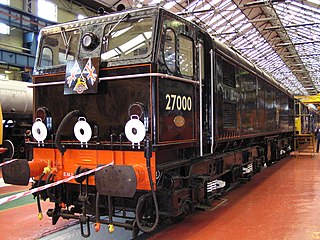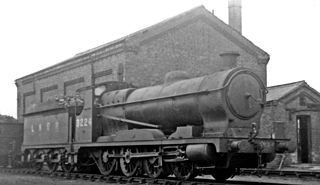
A motive power depot (MPD) or locomotive depot, or traction maintenance depot (TMD), is where locomotives are usually housed, repaired and maintained. They were originally known as "running sheds", "engine sheds" or just "sheds". Facilities are provided for refuelling and the replenishing of water, lubricating oil and grease and, for steam engines, the disposal of ash. There are often workshops for day-to-day repairs and maintenance, but locomotive building and major overhauls are usually carried out at locomotive works.

The British Rail Class 77, also known as Class EM2, is a class of 1.5 kV DC, Co-Co electric locomotive. They were built by Metropolitan-Vickers in 1953–1954 for use over the Woodhead Line between Manchester and Sheffield.

The London and North Eastern Railway Class U1 was a solitary 2-8-0+0-8-2 Garratt locomotive designed for banking coal trains over the Worsborough Bank, a steeply graded line in South Yorkshire and part of the Woodhead Route. It was both the longest and the most powerful steam locomotive ever to run in Britain. It was built in 1925 with the motion at each end being based on an existing 2-8-0 design. The original number was 2395, and it was renumbered 9999 in March 1946, and then 69999 after nationalisation in 1948, although it retained its cab-side plate bearing its original number throughout its life. The locomotive ran for some time as an oil burner, and was tried out on the Lickey Incline in 1949–1950 and again, after the electrification of its home line, in 1955. These trials were unsuccessful, and so the locomotive was withdrawn in 1955 and scrapped.
The Manchester–Sheffield–Wath electric railway was an electrification scheme on British railways. The route featured long ascents on both sides of the Pennines with the long Woodhead Tunnel at its central summit close to the Woodhead pass. This led to the route being called the Woodhead Line.

St Blazey engine shed is located in Par, Cornwall, United Kingdom, although it is named after the adjacent village of St Blazey. It was built in 1874 as the headquarters of the Cornwall Minerals Railway but for many years was a depot of the Great Western Railway. The current depot operator is DB Cargo and the depot TOPS code is BZ.

The London and North Eastern Railway Class P1 Mineral 2-8-2 Mikado was a class of two steam locomotives designed by Nigel Gresley. They were two of the most powerful freight locomotives ever designed for a British railway. It was initially intended they be a more powerful 2-10-0 version of the earlier Class O2 2-8-0s. The design was submitted in August 1923, for use between Peterborough and London, and also between Immingham and Wath marshalling yard. The power was quoted as being 25% more than the O2.

Immingham engine shed, also known as Immingham depot, or more recently as Immingham TMD and always locally as Loco is a railway maintenance depot located on the Immingham Dock estate, in North East Lincolnshire, England. The depot code is IM.

The North Eastern Railway (NER) Class H, classified as Class Y7 by the London and North Eastern Railway (LNER) is a class of 0-4-0T steam locomotives designed for shunting.

The Great Central Railway Class 8H was a class of 0-8-4T steam tank locomotives designed by John G. Robinson for hump shunting at Wath marshalling yard.

The NER Class X was a class of 4-8-0T tank locomotive designed by Wilson Worsdell for the North Eastern Railway. They were intended for use as powerful shunting engines to arrange and move coal wagons for loading into ships. In total 15 were built, 10 by the NER between 1909 and 1910, and a further five in 1925 by the London and North Eastern Railway (LNER). They had three cylinders with divided drive: the inside cylinder driving the leading axle, the outside cylinders driving the centre.

Stratford TMD was a traction maintenance depot located in Stratford, London, England close to the Great Eastern Main Line. It was located just west of Stratford station, on a site now occupied by Stratford International station. The depot was at one time the biggest on the London and North Eastern Railway with locomotives covering duties from express services to freight workings in London's docks.

The Great Central Railway (GCR) Class 8A was a class of 0-8-0 steam locomotive built between 1902 and 1911 for handling heavy coal trains over the Pennines. They all passed to the LNER in 1923, who redesignated them Class Q4. They were withdrawn from service between 1934 and 1951.
There were a number of engine sheds and railway works located in York. The large York North engine shed became the National Railway Museum in 1975.

Ipswich engine shed was an engine shed located in Ipswich, Suffolk on the Great Eastern Main Line. It was located just south of Stoke tunnel and the current Ipswich railway station. Locomotives accessed the site from Halifax Junction which was also the junction for the Griffin Wharf branch of Ipswich docks. The depot opened in 1846 and closed in 1968 although the site remained in railway use for a further thirty years.

The NER Class 290 was a class of 0-6-0T steam locomotives of the North Eastern Railway (NER), rebuilt from an earlier class of 0-4-4T, the NER Bogie Tank Passenger.
West Auckland railway station served the villages of St Helen Auckland and West Auckland in County Durham, England, between 1833 and 1962. It was on the railway line between Bishop Auckland and Barnard Castle. There was a locomotive depot, which was the only one to be both closed completely and later reopened by the London and North Eastern Railway.

Tees Marshalling Yard is a railway marshalling yard, used to separate railway wagons, located near Middlesbrough in North Yorkshire, Northern England.
Colchester engine shed was a motive power depot located in Colchester in the county of Essex in the UK. The original depot dated back to the opening of the Eastern Counties Railway (ECR) in 1843 and a second engine shed was built following the opening of the Eastern Union Railway in 1846. The ECR shed closed and the EUR shed was in use until November 1959 when the line was electrified and Colchester station rebuilt. A smaller two track engine shed was provided south of the station and after closure in the 1990s it was used for the stabling of diesel and electrical multiple units. It is currently known as Colchester Carriage Servicing Depot and units can be washed externally and cleaned internally on site.
The Condor was an overnight fast freight train service operated by British Railways between London and Glasgow from 1959 until 1965 with all freight carried in containers. The name was derived from 'CONtainers DOoR-to-Door'.
















